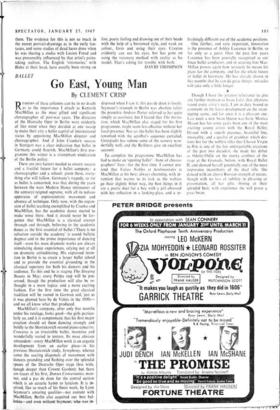Out on a Limb
IT is with a sense of relief and gratitude that one heads out east again to the Whitechapel Gallery—relief that the financial crisis of the
last few months which threatened to close the place is apparently over, gratitude that the most actively influential exhibition policy we have had in this country since the war can now continue.
One only hopes that the policy will be supported in the future from a position of strength and not hedged in with premonitions about being once bitten, twice shy. For Whitechapel has been, for well over a decade, the one place in London which has repeatedly put on the exhibitions
which needed to be seen, at the time when they were needed. Its unique contribution has been
not merely that of a public service, so to speak, but that of direct involvement in the art of its time: its shows have been the sort which influence artists themselves. It has been a pace- setter, an eye-opener, a place for vital re-assess- ments, consolidations and new departures.
It has also been the place where one is con- stantly reminded that art is as various as human beings and should be valued accordingly. From time to time the Whitechapel—by which one means Bryan Robertson, its director—has cut right across fashion, the 'mainstream' (or what- ever you like to call that tendency in the arts at any one period to leave certain quieter individuals out in the cold, to pass by on the other side) and has given major exhibitions to artists who have, for indifferent reasons, been otherwise neglected. Sometimes this policy has looked excessively quixotic or generous, and put reviewers like myself on the spot. Who can say such exhibitions are not worth it? Now, true to its best and most intransigent traditions, the gallery has reopened with just such an exhibition, a full-scale retro- spective of drawings and paintings by John Craxton. I don't like it. In fact, I think a lot of it, more particularly the latter work, is bad. But this is part of what English painting is, whether you find the fact regrettable or not.
Craxton's work revolves round two emotional centres—the romantic-pastoral idea derived from Samuel Palmer which was current in the early 1940s, and the life and landscape of Greece where he has spent more and more of his time since 1946. They are linked to the extent that the second proved to be almost the waking reality of which the first was a northern -dream. And it is possibly this extension of the one into the other which has helped trap the artist in a kind of mannerism which has looked increasingly false.
Like others in those 'romantic 'forties,' Craxton developed the Palmeresque vision in a hybrid, quasi-surrealist style which involved elements of Picasso, of Mir6 whose work he had seen in Paris, and of Sutherland with whom he had travelled and worked in Pembrokeshire. It was intense, linear, spiky, heavy with poetry and bad nothing to do with observed reality. Greece, which was observed reality, has intensified a stylisation which started off, suitably enough, to express an imaginary world, and the result has been an increasingly strained artificiality. An arti- ficiality not only of style, where light and clarity are rendered only as shrill colour and sharp, flat, linear pattern, but an artificiality of mood, which sentimentalises the actual life of goat and shepherd-boy by continuing to make them look like the Stuff of poetic romance.
Craxton appears to-be a rather fine, nervous draughtsman on those occasions when his decora- tive mannerisms don't dictate what his forms are to be ,before he's even had time to think about them. The evidence for this is not so much in the recent portrait-drawings as in the early fan- tasies, and some studies of dead hares done when he was sharing a studio with Lucien Freud and was presumably influenced by that artist's pains- taking realism. The English 'visionaries,' with Blake at their head, have usually been strong on line; poetic feeling and drawing out of their heads with the help of a borrowed style, and weak on colour, form and using their eyes. Craxton evidently can use his eyes, but has gone on using the visionary method with reality as his model. That's asking for trouble with both.
DAVID THOMPSON



































 Previous page
Previous page